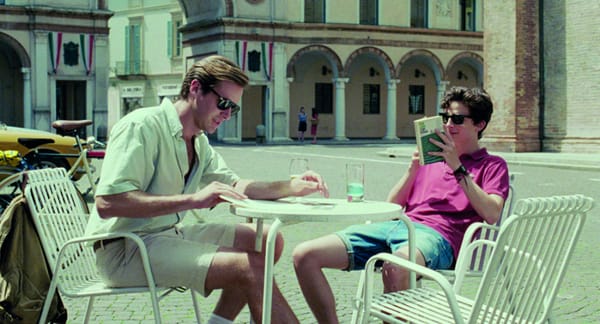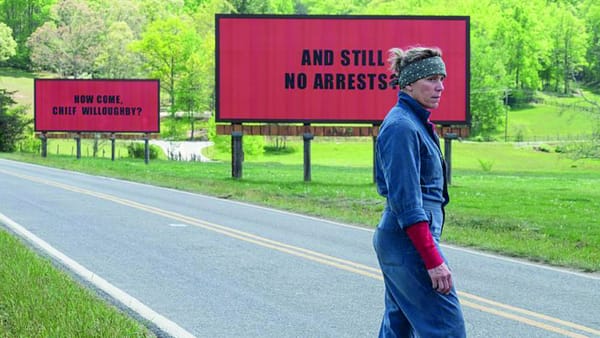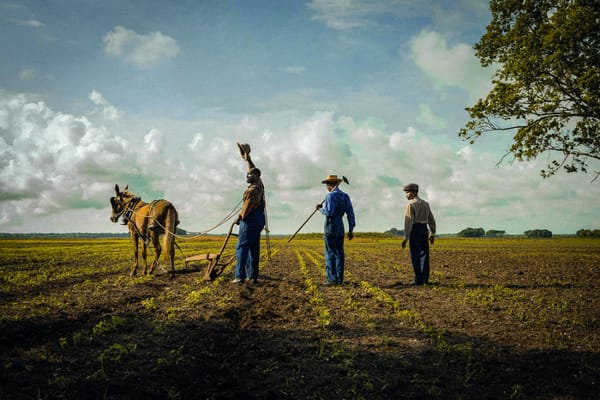BBC’s Blue Planet II – A natural masterpiece
Countless hours went into the making of this sublime series, which highlights the urgent need for us to clean up our act.

The BBC’s nature documentary series Blue Planet II comes 16 years after the original ground-breaking programme arrived on our television screens. Narrated by none other than Sir David Attenborough, scored by the Academy Award winning composer Hans Zimmer, and using the latest in camera technology, such as suction-cupped cameras mounted to the backs of killer-whales, Blue Planet II chronicles the untold stories of our ocean’s creatures like never before.
To reveal the lives of these sub-aquatic animals over seven episodes, the Blue Planet II teams spent five years researching and filming for the series. This amounted to 125 expeditions in 39 countries and over 6,000 hours of footage – a testament to the BBC teams’ tenacity and ingenuity.
Attenborough’s narration is colourful and heart-warming, with the camera-work nothing short of a visual marvel. Zimmer’s mastery of music is the perfect accompaniment to the visuals, as though each note was composed, bespoke, for each frame. This all culminates into a treat for the eyes, ears, and soul.
The nature documentary series has received a reception akin to that of a Hollywood blockbuster: the first episode was the most streamed program on BBC iPlayer in 2017, with over 4.2 million views to date. Discoveries previously unknown to science, events never before captured on camera, and a vivid message about our own impact on the oceans that may well change the way people and governments think about the seas – these are a few of the achievements of Blue Planet II thus far.
Clever fish (episode one, One Ocean)
In the first episode, we meet a remarkable little fish that challenges our understanding of fish intelligence. The tusk fish is named after the six chaotic teeth it uses to grip onto hard-shelled clams. It takes a single clam to a special coral, where it then proceeds to whack it against a protruding, anvil-like rock. After more than fifty hits, the determined fish eventually breaks through to the meat, claiming its reward.
That fish can have the ability to use tools was a remarkable discovery for the filming team. In the final episode, we learn that this particular fish was given the name Percy, the persistent. We meet Alex, the cameraman who had been diving in these waters since he was five and had filmed Percy. He describes the utter devastation caused by the coral bleaching events that took place during the time of filming: Percy’s coral kitchen, once vibrant and colourful, turns a skeletal white, creating a lump at the back of our throats.
Sinking into the darkness of an alien world (episode two, The Deep)
The second episode takes us to a place we know less about than the surface of the moon: our deep oceans. We voyage from deep sea brine lakes, where an eel spasms out of control as it is poisoned by the harsh conditions, to the Mariana Trench, deep enough to swallow Mount Everest and where life on earth may have begun.
The sequence following a 30-tonne whale carcass sinking from the surface to the sea floor was the most memorable. The whale creates a culinary bonanza for the creatures of the deep. The audience’s jaws drop as six-gill sharks come from far and wide, eventually covering the body of the whale, ravenously tearing off chunks of flesh to satiate their appetites, developed after nearly a year of fasting. Crabs and other scavengers clear the carcass leaving nothing but bone after 3 months. This bone is eventually consumed as well, finishing off the circular recycling process.
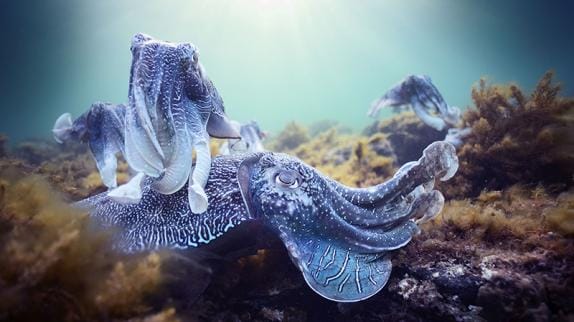
Chaos in coral cathedrals (episode three, Coral Reefs)
Coral occupies less than one-tenth of one percent of the ocean floor, yet is home to a quarter of all marine species. We saw scenes of octopus teaming up with grouper, using signals to communicate with each other to catch a meal, as well as cuttlefish mesmerising their prey with their iridescent glow before dispatching it.
The most unforgettable moment however, comes when, on one of the most remote and pristine reefs in the world, huge grouper come together in their thousands to spawn. The thrilling sequence shows the animals racing towards each other to fertilise eggs that would produce the next generation. In the mating commotion, however, sharks took advantage of the distracted fish, and picked off lovers one-by-one.
Nowhere to hide (episode four, Big Blue)
Detailing the desert-like vastness of the open ocean, this episode’s most remarkable story was one once confined to the legend of ‘the boiling sea’.
In a remote corner of the Pacific Ocean, we witness a feast of gargantuan proportions. Amongst the hundreds of diners were spinner dolphins, aptly named for the spontaneous aerial pirouettes they do mid-swim; tuna who trail-blazed a way to the action at 40 miles an hour; mobula rays with two-meter wingspans and gaping wide mouths; and sail-fish, amongst the fastest fish in the sea. They swarmed around a massive shoal of tiny lantern fish who had nowhere to hide.
Debunking the myth, the aerial camera shot shows the sea frothing like boiling water in the middle of the otherwise featureless ocean from the commotion caused by the feeding frenzy. The onslaught lasted less than 15 minutes but decimated the shoal of fish, leaving behind nothing but silvery scales, falling like snow into the ocean’s depths.
A fisherman’s tale, it’s easy to imagine how, when sea-men of the past witnessed this event, they may have mistaken the sea to be boiling as bubbles rose around their boats suddenly in an otherwise featureless blueness.
Most life lives where it’s green, not blue (episode five, Green Seas)
A common octopus off the coast of South Africa stole the show in this episode, dazzling scientists in the process. Living in kelp forests, with over 100 species of shark who have octopus on their menu, it must make a living hiding in nooks and crannies and ambushing unsuspecting crabs. A Pyjama Shark however, named for its skin, which looks like striped PJs, squeezes into the octopus’ hiding crevice and in a flurry of movement catches it in its jaws. It all seems over but the clever eight-legged mollusc sticks its tentacles into the shark’s gills, essentially choking it, and so forcing it to let go.
Its name perhaps doesn’t do this remarkably clever animal justice. The octopus, now in the open, attaches shells and debris to the suckers of its tentacles, protecting itself in armour and hiding in plain sight, thus confusing the shark, allowing it to eventually escape and live another day.
A notable contender for the most memorable scene was that of sea otters. These sea-dwelling fur balls were once hunted to the brink of extinction for their coats, but have now made a recovery thanks to remarkable conservation efforts. We are treated to cuteness that would rival any YouTube cat video as a mother preens and conditions its tiny pup’s coat to fluff it up, making it buoyant, allowing it to float in the sea! The sea otter’s recovery had secondary effects, maintaining the health of kelp forests which play an important part in trapping carbon dioxide, countering climate change.
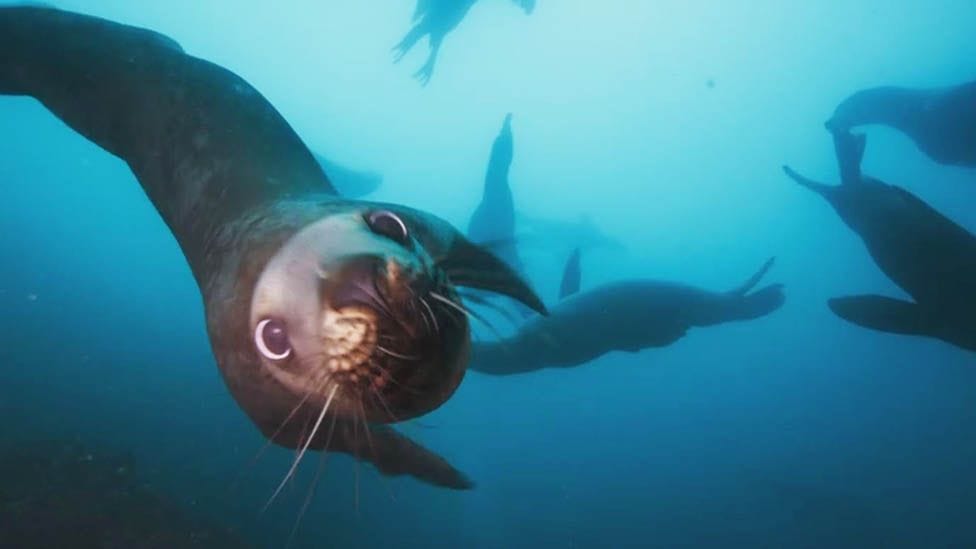
Animals run the gauntlet from land to sea (episode six, Coasts)
We follow a group of bachelor Galapagos sea lions hunting tuna. The 60-kilogram fish would be much too fast for the marine mammals in an open-sea race and so, to catch their prey, the sea lions employ their wit and cunning: they drive a few tuna into a shallow, rocky cove by the coast where there is a greater chance for them to land a catch.
Initially, one male attempts this alone to no avail, as the slick tuna give him the slip. He then comes back with reinforcements. Multiple sea lions, with a strategy to rival an NFL side, all take up their roles for the hunt. Some drive the tuna into the coves whilst others wait at the entrance to prevent their escape.
The stunning drone footage captures the sequence in the crystal-clear waters and leaves the audience mesmerised, waiting with bated breath to see whether the band of brothers are triumphant. They are, and at the end you see the efforts and time that went into producing the 7-minute scene.
The problems that we create and only we can solve (episode seven, Our Blue Planet)
The final episode sheds light on the extent to which humans are degrading the seas and threatening the existence of the creatures who dwell within them, which have delighted us over the previous episodes. Throughout the series, there were hints at the extent to which humanity was degrading our blue planet, but in the finale this inconvenient reality is laid bare, forcing the viewer to pause for introspection because in reality, there is no planet II. Although casting a sombre tone, its overall message is one of hope, as we meet the incredible people dedicating their lives to safeguarding the seas and its wonders.
We meet Len, from Trinidad and Tobago, who was met with resistance, aggression, and threats to his safety when he first started protecting his island’s Leatherback sea turtles after realising there was an imminent risk of extinction if nothing was done to protect them. These giants, weighing nearly half a tonne, came to the shores to lay their ping-pong-ball-sized eggs, during which time they were defenceless and were commonly killed for their meat.
Poachers who once hunted them, however, now play an integral part in their conservation. Children are taught about their natural heritage in school, and the local economy is also benefitting, as tourist flock to catch a glimpse of these ocean behemoths. Len and his team’s tireless efforts now mean that the beaches of Trinidad and Tobago are home to the best populations of Leatherbacks in the world!
Perhaps the most pertinent message put to us all relates to our infatuation with plastics, especially those of the ‘disposable’ and the ‘convenient’ type. 8 million tonnes of the stuff find its way into our oceans each year, wreaking havoc on marine life in even the remotest corners of the globe. Broken down plastic and industrial effluent produce a toxic soup which enters the food-chain, killing creatures like the dolphins, whales, and seabirds we came to adore. The macabre scene of a pilot whale carrying her dead calf in episode four after its milk had been laced with environmental plastic molecules was a troubling reminder of our need to reassess our relationship with the material.
The episode and series as a whole gave us a number of bitter pills to swallow. David Attenborough, however, is perhaps the only person able to make a nation, and maybe planet, take it.

Of all the many stars in the show, the most remarkable was one of our own: Sir David Attenborough. He held our attention and awe throughout each episode, and in the finale, like a benevolent grandparent, he held our hand whilst gently delivering the message that we had to be more careful and take care of the world we live in. It had to be him though. Were it anyone else, we would have no doubt snatched away our hand like an infant throwing a tantrum. His oratory genius, authentic delivery, and ability to remove any scientific distance from the audience, left us with a sense of optimism and encouragement, rather than one of sorrow and despair.
Sir David provided a rejuvenation for the human spirit. At the age of 91, he still displays the fascination and curiosity of a child, marvelling at the creatures he has spent his life documenting. However, he also provides us all with sage wisdom. In his final monologue, he states that “Never before have we had such an awareness of what we are doing to the planet and never before have we had the power to do something about that. Surely, we have a responsibility to care for our blue planet. The future of humanity and indeed all life on Earth now depends on us”.
Rather than being complicit in its destruction, perhaps we can now be a part of the oceans salvation?
Blue Planet II is available on BBC iPlayer

